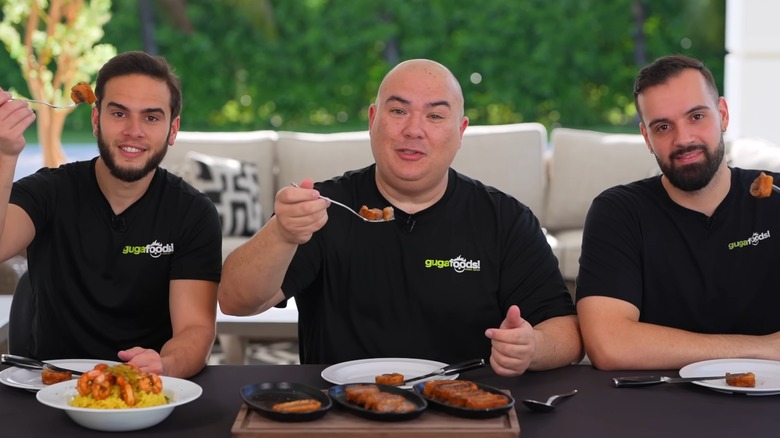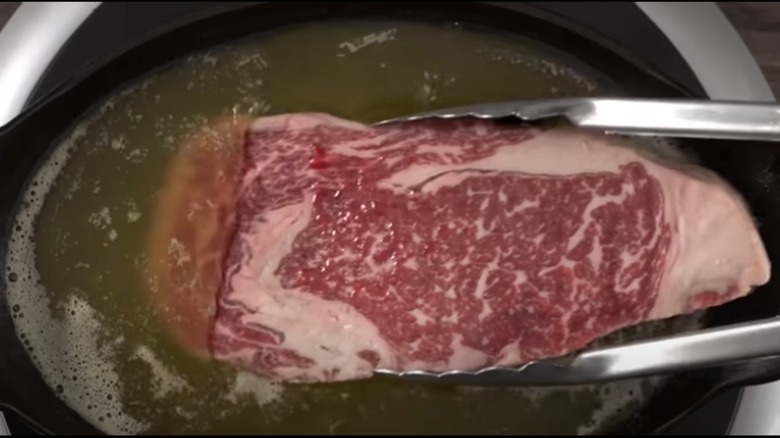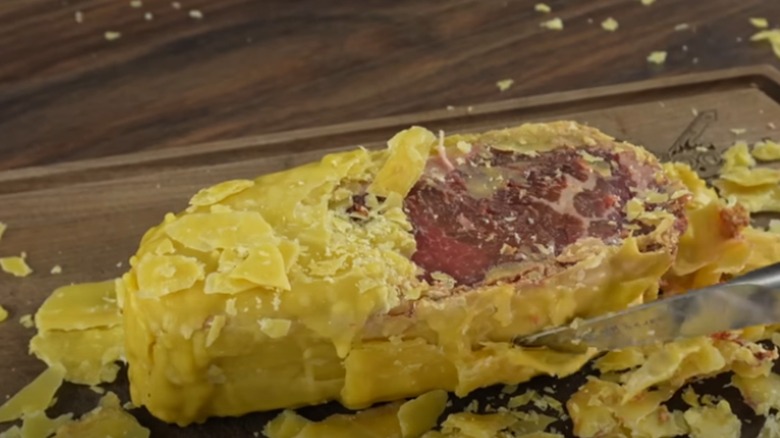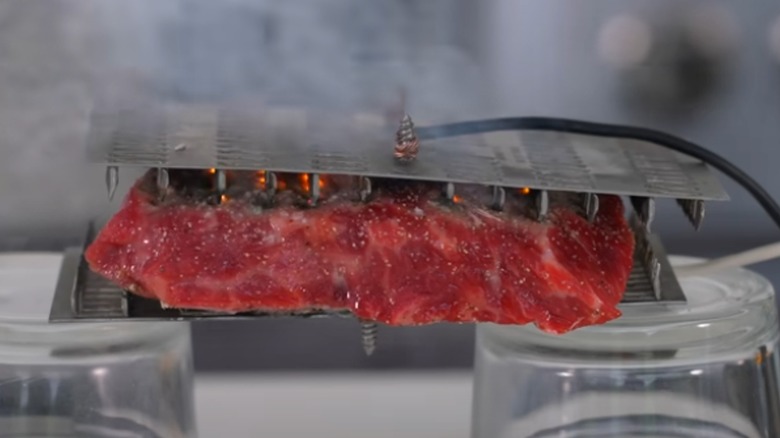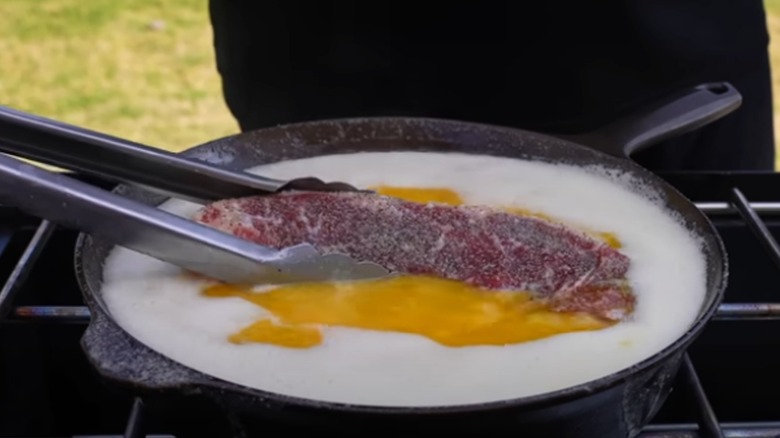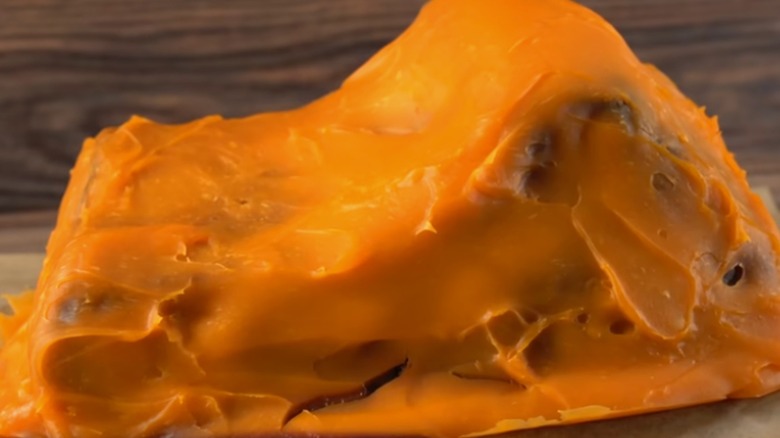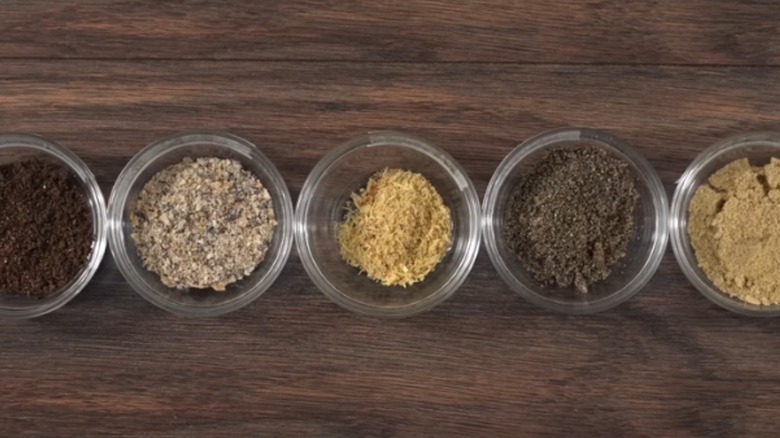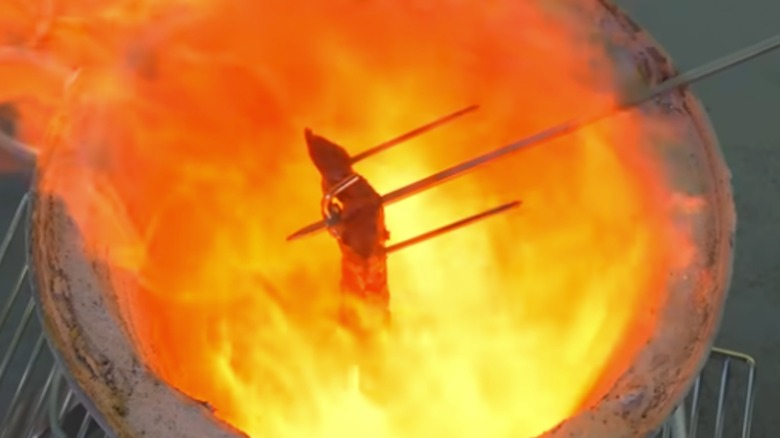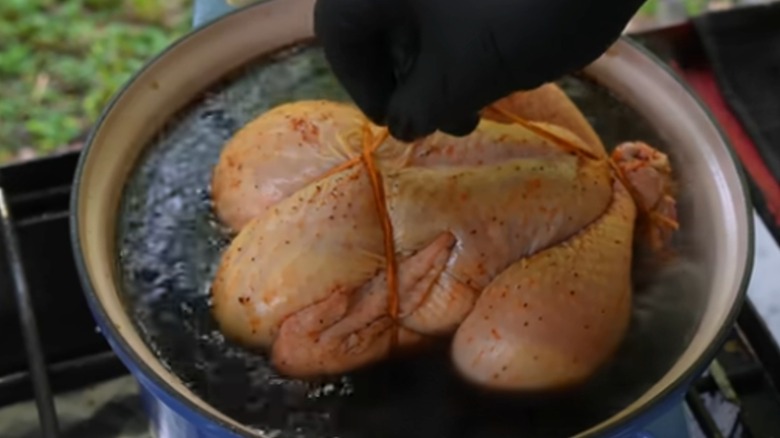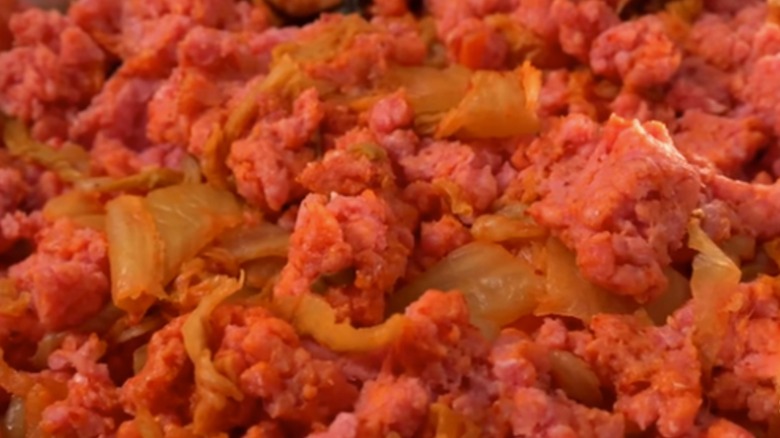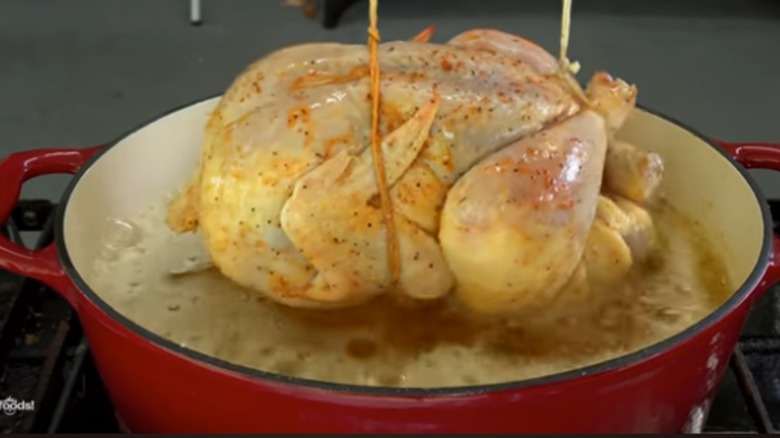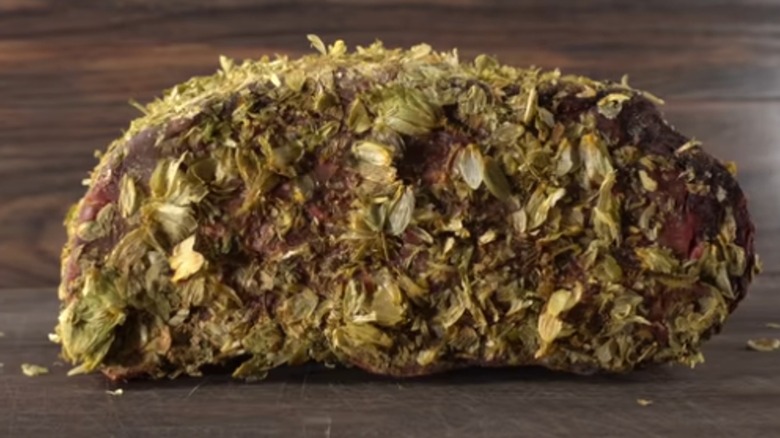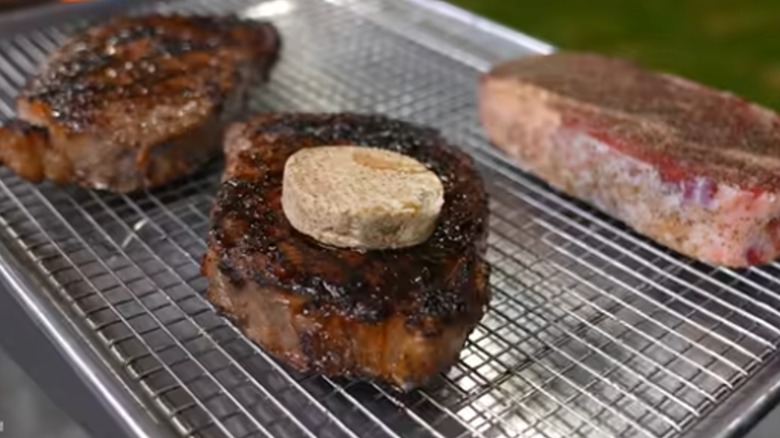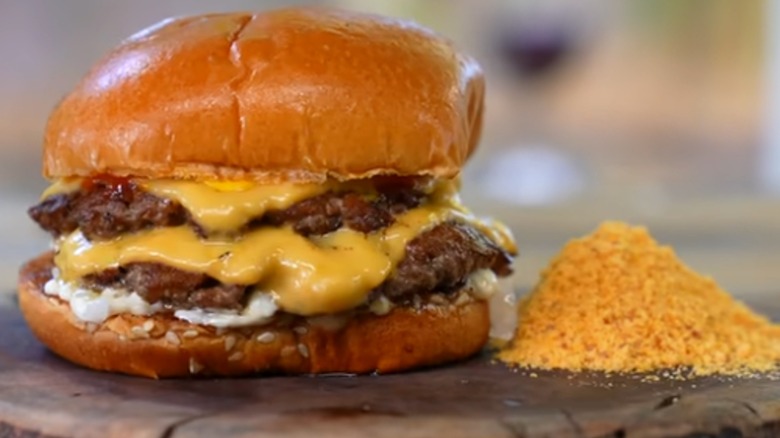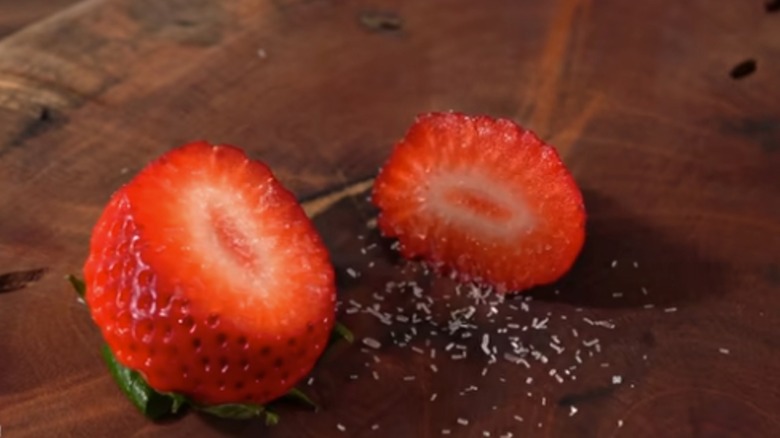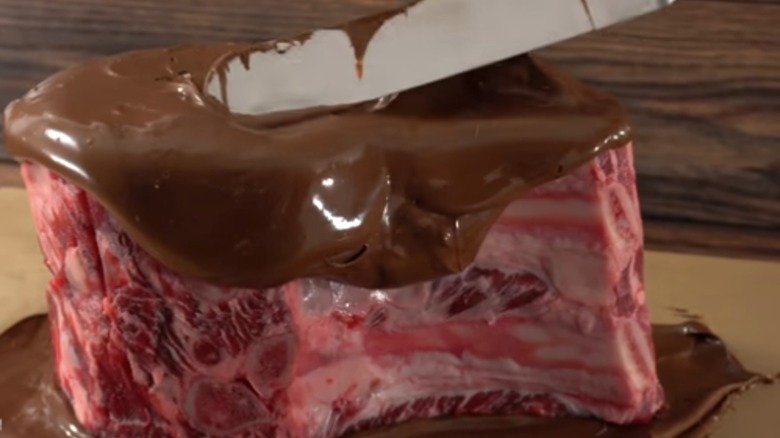Guga Foods' Top 15 Wildest Food Experiments
If you're a fan of wild food experiments, the Guga Foods YouTube channel is a great place to find them. The channel has amassed over 4.49 million subscribers since it began in 2015. The host is Brazilian-American Gustavo Tosta, who started making videos on how to create the perfect rice or Brazilian barbecue steak. In 2018, he began experimenting, starting out fairly tame, like trying to find the best way to tenderize a steak. He soon realized he was onto something, and his experiments took off.
Tosta and his friends all love steak, so most of the experiments on the channel involve steak. However, he does test a few other ingredients like chicken and hamburger. In each experiment, he prepares the test food along with a control dish. Then he and his friends taste the results and compare them. It's difficult to choose just a few of Guga Foods' wildest experiments, but we found these to be the most intriguing ones worth sharing. Results vary, so get ready for a crazy ride.
Deep-frying steaks in bone marrow
All of the fat from the middle of a bone can lend lots of flavor to food. So Guga Foods has done a couple of experiments with deep-frying steak in bone marrow.
In one episode, host Gustavo Tosta started by rendering the marrow into liquid in the oven. He heated the marrow up to 135 degrees Fahrenheit for frying his steak. The bone marrow didn't create a crust on the steak, though, so he grilled it to finish it.
He tested the deep-fried steak alongside another grilled steak that he topped toward the ending of the grilling time with what he calls "the butter of the gods." It contains cured egg yolks, bone marrow solids, butter, parsley, dried shallots, garlic paste, and anchovy paste. The steak fried in bone marrow had a "nice, slightly mature difference," Tosta said after tasting, but it wasn't as creamy as the one made with the butter of the gods (via YouTube).
Aging steaks in beeswax for a year
Various studies show that beeswax has antibacterial and antifungal properties. So Guga Foods wondered whether it would be a good candidate to protect dry-aged steaks for a year.
Rather than extract honey from the honeycomb himself, host Gustavo Tosta decided to buy premade beeswax pellets for the experiment. He poured the melted wax over frozen steaks so that the wax would solidify once it hit the meat. Then he let the wax-coated piece of meat age in his fridge for a little over a year. Despite the coating, the meat had oxidized and smelled funky.
The testers didn't know what they were getting when they tried this steak, and, after tasting, questioned whether it was safe to eat because the flavor seemed weird and off. One tester said, "It tastes like a dry-aged steak gone terribly wrong -– a little sour, a little sweet, beefy, a little gross-like" (via YouTube). So, the beeswax wasn't the success that you might think.
Cooking steak using raw electricity
Guga Foods has lots of videos experimenting with ways to cook food using normal cooking appliances. But what would it be like to try to get lightning to cook a steak? To simulate the effect, the show got a fellow YouTuber and scientist named Nate From the Internet to help.
Host Gustavo Tosta and Nate put the steak between what looked like two metal plates spiked with nails and balanced it on drinking glasses. The sound and sight of the arcing electricity were enough to show just how dangerous this experiment is to try at home. It only took 90 seconds to cook the steak to well done. A second attempt at 45 seconds resulted in a steak that was well done in some spots and rare in others. After ensuring the steak in the third attempt had a uniform thickness and was sized to fit between the metal plates, they were able to perfectly cook a medium-rare steak in 25 seconds.
They were surprised at how good the electricity-cooked steak was. It was tender with no off-taste from the metal. Tosta said, "If I were to give you this steak ... you would have never known that it was cooked with electricity" (via YouTube). While the method cooked the steak faster and yielded tasty results, it's not the safest way to cook steaks at home.
Deep-frying steaks in Papa John's garlic sauce
One of the best things about eating Papa John's pizza is the special garlic sauce that comes on the side. It's made for dipping rather than cooking, but would it work for frying steaks? Guga Foods wanted to know, so Gustavo Tosta experimented with a couple of different methods.
He cooked one steak on the grill as usual, basting it with Papa John's garlic sauce toward the end. The resulting steak was extremely juicy and flavorful. The testers describe it as being savory, rich, and creamy.
The other cooking method started on the stovetop. Tosta emptied 50 sauce cups into a deep skillet, added the steak, and kept flipping it to get it evenly cooked. Since this method yielded no crust, he finished the steak on the grill. The taste-testers were flabbergasted by how good the final result was. One of them said, "It has the most amount of richness, the most amount of creaminess," and "it tastes like one of the juiciest steaks I've ever had with an amazing rich flavor" (via YouTube).
Dry-aging steaks in Cheez Whiz
Since people seem to love the idea of eating beef and cheese together, Guga Foods tried dry-aging rib roast in cheese before turning it into steaks. Coating the meat, though, required a spreadable type of cheese: Cheez Whiz.
Gustavo Tosta spread two jars of Cheez Whiz over the roast before dry-aging it in the fridge for 35 days. As it aged, the cheese solidified. The initial smell was off-putting, but by the time Tosta finished trimming off the cheese and cutting the meat, he was left with beautiful steaks that were extremely tender and smelled good.
The Cheez Whiz-aged steaks had a more funky flavor than ordinary aged steaks. One tester said he could detect the Cheez Whiz flavor after learning what he was eating and said it reminded him of steaks cooked with MSG. Tosta said the similarity was because "the flavor lingers in your mouth, and it stays there" (via YouTube). Overall, the testers thought it was an interesting flavor experiment that wasn't bad.
Seasoning steak with fruit seeds
Most people normally throw fruit seeds away, but Gustavo Tosta wondered why not try using them as food seasoning, like black pepper. The seeds for this Guga Foods experiment included lemon, papaya, dragon fruit, watermelon, and rambutan, which is a tropical fruit. All these seeds seem nutritious and fairly harmless except for rambutan seeds, which may possibly be toxic in large amounts (per Healthline).
All the seeds were dehydrated and ground into powder before being sprinkled on top of grilled steak. The watermelon seeds were disappointing and didn't provide any flavor at all, while the rambutan seeds tasted like dirt, according to the testers. The papaya seeds and lemons were horribly bitter, with the testers spitting the steak out of their mouths in disgust. Tosta said of the lemon seeds on the steak, "That's probably one of the worst things I've ever put in my mouth" (via YouTube). The papaya seeds also had an unpleasant chalky texture. However, the dragon fruit seeds had citrus undertones that the guys really liked, redeeming this experiment.
Cooking steaks at 2,000 degrees Fahrenheit
In one experiment, Nate From the Internet challenged Guga Foods to cook steak in a 2,000-degree Fahrenheit furnace. Of course, Gustavo Tosta took the challenge. Nate made a homemade furnace for the challenge, and they did a few variations, including using thin steaks and wrapping the steaks in foil to rest for 10 minutes so they would cook the middle.
The one with the strongest char was a skirt steak cooked over the furnace on a grill top for 20 seconds per side. Next, Tosta tried holding the skirt steak with skewers to bypass the grill marks. It resulted in less charring and a steak cooked to perfection. Then he tried a reverse sear with a ribeye, cooking it first on a regular grill before using skewers to sear the outside of the steak over the hot furnace. This one had the advantage of the charcoal flavor from the grill, plus the charring from the furnace. The last one was a ribeye cooked completely over the furnace to give it a good char level. The testers favored the ones cooked over the furnace on skewers rather than the grill top since they had less char. And resting them in foil so they continued to cook was the right call. Tosta said, "I think I got lucky. I'm not gonna lie" (via YouTube).
Boiling a whole chicken in five gallons of Coca-Cola
There are a lot of ways to incorporate Coca-Cola into your cooking. So, Guga Foods decided to find out how would it taste to boil a whole chicken in Coke.
As usual, Gustavo Tosta prepared a test chicken to compare with the Coca-Cola chicken. Both chickens started out with a salt and barbecue rub before being trussed. And both had brown sugar, green onions, and ginger added to the boiling liquid. However, Tosta boiled one chicken in soy sauce and the other in five gallons of Coca-Cola.
The boiling process took about 45 minutes. Unlike the one with soy sauce, the one with the Coke developed scum on the meat and in the water and smelled awful. However, both birds were moist, juicy, and flavorful. The soy one ended up with the flavors penetrating deep into the bird and had a good-textured skin. Meanwhile, the Coke one wasn't as flavorful and was slightly sweet. All the testers preferred the soy one but still thought the Coke one was "a step up from regular chicken" (via YouTube).
Fermenting meat to make a burger
Fermentation is one of the oldest ways to preserve meat. Since fermentation makes so many things taste better, Guga Foods hoped the process would yield the ultimate grilled burger.
Gustavo Tosta tried two different fermented burgers. For the first burger he mixed ground beef with fermented milk, which uses lactobacillus bacteria. He placed the meat in a warm oven for exactly two hours — any longer creates a dangerous condition that food safety experts say you should avoid. For the other burger, he mixed ground beef with kimchi, which is fermented vegetables. Both versions then rested in the fridge for three days. When it came time to grill the meat, he removed the veggies from the kimchi ground beef. Neither version had much oxidation. However, the fermented milk one smelled a bit like rotten milk.
The testers were all impressed with the fermented burgers. The fermented milk one had a sweet and fruity flavor, almost like it had a blueberry marinade, they said. Plus, it had a pleasant funky sourness. However, the kimchi burger was the real hit. It had a fermented sourness that everyone loved. One tester said, "I could see this being like someone's favorite burger" (via YouTube).
Boiling a whole chicken in 10 pounds of butter
When it comes to over-the-top experiments, boiling a whole chicken in 10 pounds of butter is right up there. Guga Foods hoped it would provide amazing flavor to the bird.
Host Gustavo Tosta decided to smoke a chicken as his control to compare with the butter bird. He dry-brined both chickens with salt and added barbecue rub before refrigerating them for 24 hours. For the boiled chicken, he clarified the butter to remove milk solids so that it wouldn't burn. He then boiled it in a Dutch oven at 350 degrees Fahrenheit for 20 minutes.
The smoked version was smoky and juicy with balanced flavors. Even though the butter-boiled one had the exact same seasonings, it didn't taste as spicy or well-seasoned. And it wasn't as juicy as the smoked one. And none of the testers mentioned a buttery flavor. Tosta said, "It's good, but smoked is better' (via YouTube). However, we wished he'd tried boiling the other in regular cooking oil for a better experiment.
Dry-aging steaks in hops and beer for 35 days
Beer can really boost the flavor of a variety of foods. So Guga Foods decided to put some brew to the test with steaks. Gustavo Tosta started with a rib roast and dry-aged it for 35 days in both Guinness beer and a key ingredient in beer: hops.
He had difficulty getting the whole-leaf hops to stick to the beer-covered roast. So, he wrapped it in a cheesecloth to hold the hops in place and poured even more beer over the top. When he unwrapped it after 35 days, it filled his whole house with an unpleasant stench. Luckily, after trimming the outer layer, the roast smelled like good beer. Plus, the beer hops preserved the meat in a way that allowed him to not have to trim it as deeply as the other roast he dry-aged at the same time.
The testers found the hops-aged steak to have a stronger smell than the control dry-aged steak. It was also juicier, beefier, and had an extra flavor note they couldn't identify until Tosta told them what it was. One of the testers was surprised he liked the hops-aged one better "because I'm so not a beer guy." Tosta agreed, saying, "I'm not a beer guy either" (via YouTube). So, it has appeal even to those who aren't beer fans.
Making a steak that numbs your mouth
The first time you try Szechuan peppercorns, they're a surprise because they numb the inside of your mouth. However, they also have a subtle citrus flavor. Being intrigued by this seasoning, Gustavo Tosta decided to try making ribeye steaks with it.
Tosta covered two steaks in salt and ground Szechuan peppercorns. One was grilled and then basted with a Szechuan peppercorn-infused Wagyu tallow. For the other, he topped it with Szechuan peppercorn compound butter during the grilling process. The compound butter was a combination of butter, parsley, and ground Szechuan peppercorns.
When the testers tried the one with seasoned oil, they found that the numbing sensation didn't occur. The peppercorns did give the steak a subtle citrus flavor. The steak made with Szechuan compound butter was another experience entirely. The steak had more of the peppercorn flavor and did numb their mouths. Tosta said, "It is extremely powerful, maybe because I put way too much on it" (via YouTube). So, if you want to try it, maybe go lighter on the peppercorns in your compound butter.
Turning burgers into dust to make them better
YouTube sensation MrBeast (aka Jimmy Donaldson) created the MrBeast Burger that sells out of ghost kitchens for delivery only. So Guga Foods decided to try something unusual -– turning those burgers into a powder to season new burgers.
Gustavo Tosta took a full MrBeast Burger containing pickles, special seasoning, American cheese, mayo, ketchup, onions, bun, and burger and freeze-dried it for two days. Then he put it into the food processor to make a powder that he called Beast Dust. The resulting dust had an extremely cheesy flavor. Finally, Tosta made crispy-edged smash burgers like the ones done by MrBeast Burger and sprinkled Beast Dust on top.
The results were wow-worthy and an instant 10 out of 10. Not only did the Beast Dust give the burger a better flavor, but it also provided a better texture. One tester detected "a little bit of like powderiness that mixes in with the cheese and everything else — super nice." Tosta said that it was "not only more cheeses. It has more umami, everybody -– more flavor" (via YouTube). After MrBeast tasted it, he wanted the Beast Dust to use in his own burgers.
Trying MSG on everything
Monosodium glutamate (MSG) has the reputation of making food taste better, but does it make everything taste better? Gustavo Tosta of Guga Foods wanted to find out, so he tested a wide variety of foods sprinkled with MSG, which has an interesting history.
Several foods changed for the better. Strawberries became sweeter and lost their sourness, while carrots tasted more fresh and crisp. McDonald's Chicken Nuggets acquired a spicy flavor. MSG enhanced the chocolate chip cookies, with the flavor lingering longer. Adding it to chocolate ice cream made it taste milkier and more chocolatey with a pleasant saltiness. The testers seemed to like MSG best on kimbap (Korean sushi), where it enhanced the flavors of everything from the pickled radishes to crab.
However, MSG wasn't an improvement for everything. For example, french fries tasted saltier, and McDonald's cheeseburgers tasted stronger. Some foods simply tasted different, like whiskey and raw zucchini. MSG-enhanced cheese tasted saltier and stronger, but the original was better. Not surprisingly, MSG brought out the cheesiness in pizza, but it also enhanced the cardboard flavor from the packaging. Apples became salty, sweeter, and spicy, but plain apples were better. Strangely enough, putting MSG on applesauce took away flavor notes. Meanwhile, there were a few foods that didn't seem to change at all, like croissants, Jamaican patties, and Coca-Cola. Still, Tosta's suggestion is to "sprinkle a little bit of MSG, and most of the things will taste good" (via YouTube).
Dry-aging steaks in Nutella
After trying dry-aging steaks in peanut butter, fans begged Guga Foods to experiment with Nutella. So, the show obliged.
Host Gustavo Tosta covered a roast in Nutella. Then it spent 35 days dry-aging in the fridge. When the time was up, the Nutella had hardened, but Tosta was a little concerned to find meat juice and blood leaking out with the roast, which also had condensation and mold. There was so much mold that he had to trim off bones and a huge amount of meat. The meat was also super tender as if it had been marinated.
The grilled steak wasn't great. The testers immediately noticed that it had an odd smell. Tosta gave it a taste and said, "Oh, that's different," before excusing himself to spit it out. Tosta thought it tasted funky, like an old truffle, while the other tester said it tasted like it had been dry-aged for too long. Tosta declared it "a terrible experiment" and urged viewers not to try it at home (via YouTube).
